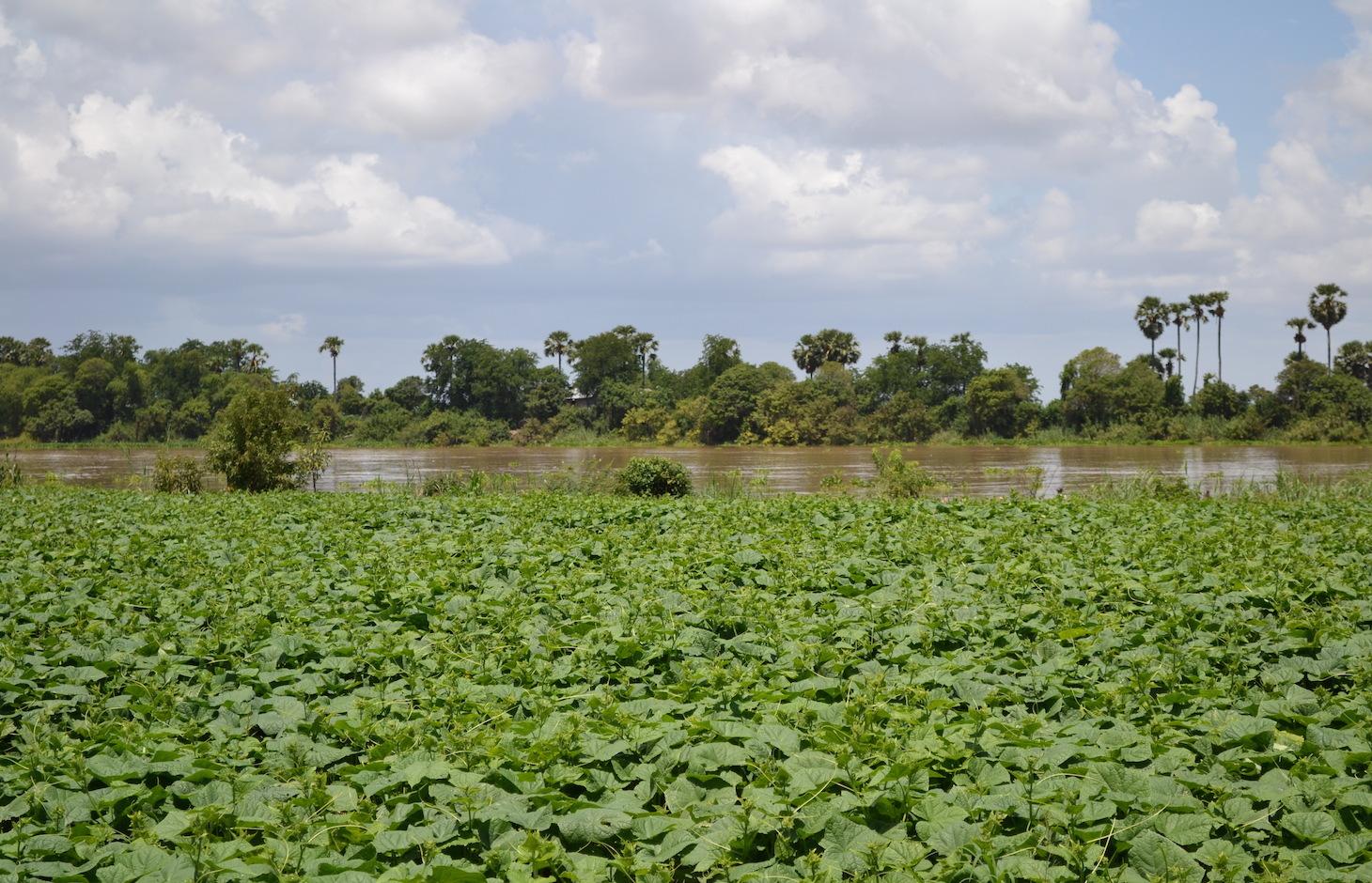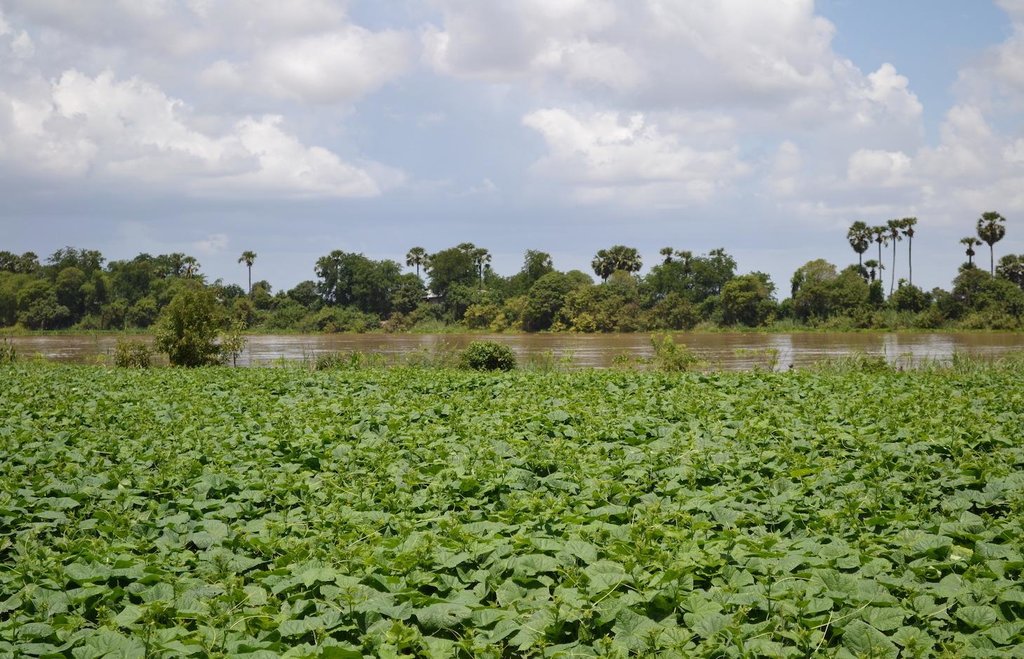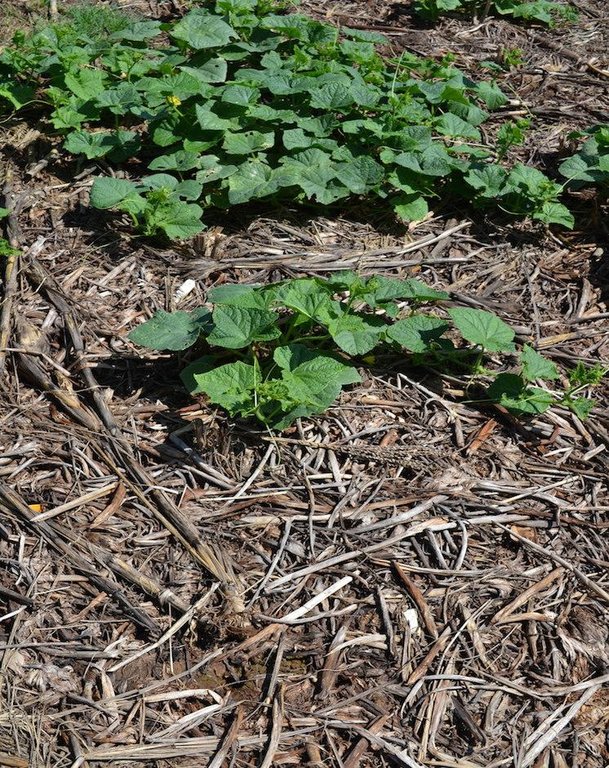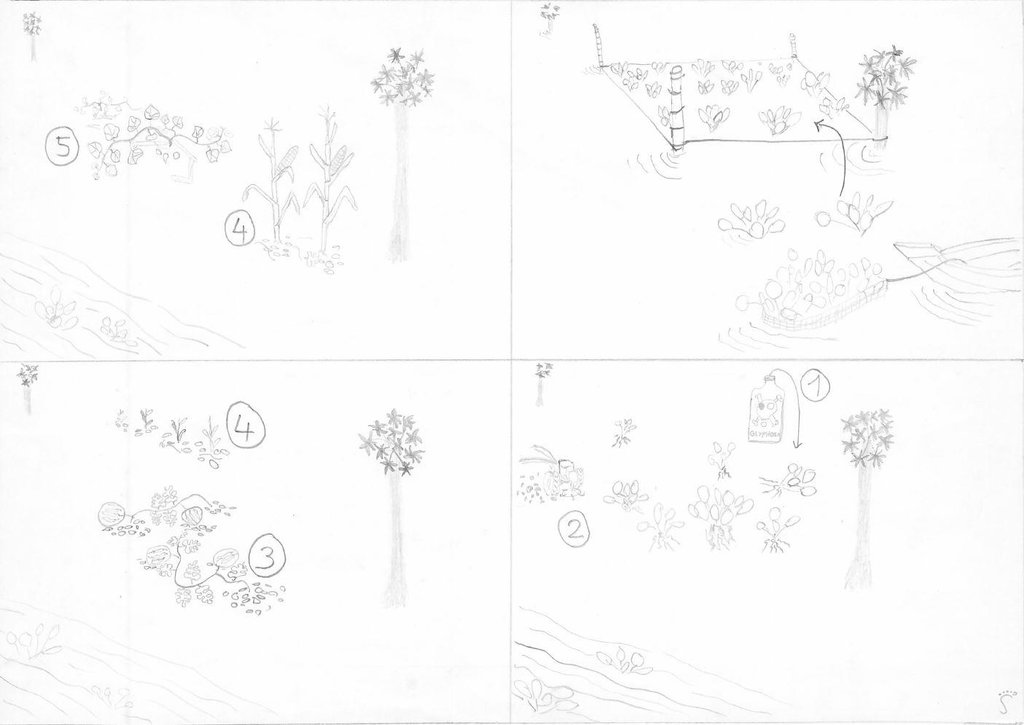Mulching with water hyacinth (Eichhornia crassipes) after the monsoon floods. [柬埔寨]
- 创建:
- 更新:
- 编制者: Christoph Kaufmann
- 编辑者: –
- 审查者: Deborah Niggli, Alexandra Gavilano
ការប្រើប្រាស់កំប្លោកជាគម្របដីដំាដំណំាក្រោយពេលទឹកសម្រក (Khmer)
technologies_1223 - 柬埔寨
查看章节
全部展开 全部收起1. 一般信息
1.2 参与该技术评估和文件编制的资源人员和机构的联系方式
SLM专业人员:
Khun Lean Hak
柬埔寨
1.3 关于使用通过WOCAT记录的数据的条件
编制者和关键资源人员接受有关使用通过WOCAT记录数据的条件。:
是
1.4 所述技术的可持续性声明
这里所描述的技术在土地退化方面是否存在问题,导致无法被认为是一种可持续的土地管理技术?:
否
1.5 参考关于SLM方法(使用WOCAT记录的SLM方法)的调查问卷

Model farmer [柬埔寨]
Model farms were introduced by a NGO in order to spread knowledge about SLM (compost, System of Rice Intensification SRI, and other technologies) in the project area.
- 编制者: Christoph Kaufmann
2. SLM技术的说明
2.1 技术简介
技术定义:
Water hyacinth (Eichhornia crassipes) is collected during the monsoon floods, attached to poles on the flooded fields, chopped when the water recedes and used as mulch to plant different crops.
2.2 技术的详细说明
说明:
This mulching technique is used at the riverside of the Tonle Sap River. The area is flooded during the late rainy season (September to November), and alluvial mud is deposed on the fields, which enhances the soil fertility. The deposition of sediments depends on the extent of the yearly flood, and is threatened by the construction of hydropower dams on the upper Mekong River (Thomas et al. 2012:49), as well as climate change (floods tend to be smaller or more extreme). During the dry season (approximately from January to June, depending on precipitation patterns) the land dries and due to high temperatures and very low precipitations, crops can be harmed.
At first, the farmer gathers the water hyacinth with his boat during the wet season. He surrounds them with a net and pulls them to his fields, where he prepares fences with bamboo poles and iron wires. He fills the fenced area with the water hyacinth. Once the water recedes, he sprays glyphosate on the water hyacinths and chops them by using a hand tractor. He plants his first crop, watermelon, as soon as the soil is dry enough (start of dry season). The crop residues of the watermelon are left on the fields, and he can plant a crop of corn and a crop of cucumber before the next flood enters.
The analyzed area is flat (slope < 2%), tropic (dry and wet season), and the soils are mostly loamy. The groundwater table is rather high with 1-2 m during the dry season (November to May). The area is flooded during and after the wet season (August-September to November). The floods bring sludge and thus nutrients to the fields.
Due to climate change, the rainfalls are more erratic, temperatures rise and droughts are more recurrent. Chili is the cash crop predominantly grown in the flooded area, with floating rice as second crop.
Agricultural activity in this region is confronted with high migration rates (garment industry, cities, or other countries). This is detrimental for the farmers, since there is less labour force available. Also, the presented technology requires a rather high initial investment (especially when a tractor is bought) and an increase of physically strenuous labour. Therefore, the interviewed land user stated that most farmers are reluctant to do high investments on their farm. This is aggravated due to the fact that taking up credits might increase the dependency of the farmer.
2.3 技术照片
2.5 已应用该技术的、本评估所涵盖的国家/地区/地点
国家:
柬埔寨
区域/州/省:
Kampong Chhnang
有关地点的进一步说明:
Kampong Os
具体说明该技术的分布:
- 均匀地分布在一个区域
如果技术均匀分布在一个区域,则指定覆盖的区域(单位为平方千米):
0.02
如果不知道精确的区域,请注明大致覆盖的区域:
- < 0.1 平方千米(10 公顷)
注释:
Total area covered by the SLM Technology is 0.02 km2.
2.6 实施日期
如果不知道确切的年份,请说明大概的日期:
- 不到10年前(最近)
2.7 技术介绍
详细说明该技术是如何引入的:
- 通过项目/外部干预
注释(项目类型等):
2010 through SOFDEC
3. SLM技术的分类
3.1 该技术的主要目的
- 改良生产
- 减少、预防、恢复土地退化
3.2 应用该技术的当前土地利用类型

农田
- 一年一作
年作 - 具体指明作物:
- 谷物类 - 玉米
- 蔬菜 - 香瓜、南瓜、南瓜或葫芦
- cucumber
每年的生长季节数:
- 1
具体说明:
Longest growing period in days: 225, Longest growing period from month to month: Mid-December to end of July
采用轮作制度了吗?:
是
如果是,请具体说明:
He plants his first crop, watermelon, as soon as the soil is dry enough (start of dry season). The crop residues of the watermelon are left on the fields, and he can plant a crop of corn and a crop of cucumber before the next flood enters.
注释:
Major land use problems (compiler’s opinion): Regular flooding, use of pesticides, low soil organic matter, monocultures.
Major land use problems (land users’ perception): Pumping machines and tubes to irrigate are not easily available. High irrigation need as the soil organic matter content is low.
3.4 供水
该技术所应用土地的供水:
- 混合雨水灌溉
3.5 该技术所属的SLM组
- 改良的地面/植被覆盖
3.6 包含该技术的可持续土地管理措施

农艺措施
- A1:植被和土壤覆盖层
- A2:有机质/土壤肥力
- A3:土壤表面处理
注释:
Type of agronomic measures: mulching, minimum tillage
3.7 该技术强调的主要土地退化类型

化学性土壤退化
- Cn:肥力下降和有机质含量下降(非侵蚀所致)

生物性退化
- Bq:数量/生物量减少
- Bl:土壤寿命损失

水质恶化
- Ha:干旱化
注释:
Main causes of degradation: soil management (Soil is left bare (not covered) in other cultivations), education, access to knowledge and support services (People don’t know about cover crops, or are afraid of the initial costs of machinery)
Secondary causes of degradation: crop management (annual, perennial, tree/shrub) (Only annuals are planted, soil is otherwise left bare. But many perennials cannot grow because of the yearly floods), change in temperature (Climate change causes higher evaporation because of higher temperatures.), labour availability (Innovations are becoming more risky as labour availability is decreasing)
3.8 防止、减少或恢复土地退化
具体数量名该技术与土地退化有关的目标:
- 防止土地退化
4. 技术规范、实施活动、投入和成本
4.1 该技术的技术图纸
技术规范(与技术图纸相关):
Top Right: during the flooded season, water hyacinths are gathered and attached over the fields.
Bottom right: after the floods, the water hyacinths are killed with herbicides (1) and chopped with a hand tractor (2).
Bottom and top left: Different crops follow each other, in this case water melon (3), corn (4) and cucumber (5). The crop residues are always left on the fields.
Kampong Chhnang
Date: 2014
Technical knowledge required for field staff / advisors: moderate
Technical knowledge required for land users: moderate
Main technical functions: improvement of ground cover, increase in organic matter, increase / maintain water stored in soil
Secondary technical functions: control of raindrop splash, improvement of surface structure (crusting, sealing), increase in nutrient availability (supply, recycling,…)
Mulching
Material/ species: Water hyacinths
Quantity/ density: n/a
Remarks: As much as the land user can keep with the bamboo poles and wires.
Minimum tillage
Quantity/ density: n/a
Remarks: Sometimes, the land user tills before the yearly floods due to time issues.
作者:
Stefan Graf, Switzerland
4.2 有关投入和成本计算的一般信息
注明雇用劳工的每日平均工资成本:
5.00
4.4 技术建立所需要的费用和投入
| 对投入进行具体说明 | 单位 | 数量 | 单位成本 | 每项投入的总成本 | 土地使用者承担的成本% | |
|---|---|---|---|---|---|---|
| 设备 | tools | ha | 1.0 | 130.0 | 130.0 | 100.0 |
| 设备 | boat | ha | 1.0 | 1000.0 | 1000.0 | 100.0 |
| 设备 | hand tractor | ha | 1.0 | 1500.0 | 1500.0 | 100.0 |
| 肥料和杀菌剂 | biocides | ha | 1.0 | 4.5 | 4.5 | 100.0 |
| 施工材料 | wires and bamboo poles | ha | 1.0 | 30.0 | 30.0 | 100.0 |
| 技术建立所需总成本 | 2664.5 | |||||
| 技术建立总成本,美元 | 2664.5 | |||||
4.5 维护/经常性活动
| 活动 | 时间/频率 | |
|---|---|---|
| 1. | Collecting water hyacinth and put poles | During the floods each year (Oct-Nov) |
| 2. | Spraying herbicide on the water hyacinth | After floods |
| 3. | Chopping the sprayed water hyacinth with the hand tractor | After spraying herbicide |
4.6 维护/经常性活动所需要的费用和投入(每年)
| 对投入进行具体说明 | 单位 | 数量 | 单位成本 | 每项投入的总成本 | 土地使用者承担的成本% | |
|---|---|---|---|---|---|---|
| 劳动力 | labour | ha | 1.0 | 35.0 | 35.0 | 100.0 |
| 设备 | machine use | ha | 1.0 | 10.0 | 10.0 | 100.0 |
| 技术维护所需总成本 | 45.0 | |||||
| 技术维护总成本,美元 | 45.0 | |||||
注释:
Machinery/ tools: Hand tractor with a chopper
The costs were calculated per ha, in 2014. There is only one farmer (2 ha) next to the Tonle Sap applying this technology.
4.7 影响成本的最重要因素
描述影响成本的最决定性因素:
The factor affecting the costs the most is the availability of cheap equipment. For the recurrent activities the labour costs were calculated as if he hired someone, but he does all by himself. The work is strenuous, as he has to walk in water and trough the water hyacinths.
5. 自然和人文环境
5.1 气候
年降雨量
- < 250毫米
- 251-500毫米
- 501-750毫米
- 751-1,000毫米
- 1,001-1,500毫米
- 1,501-2,000毫米
- 2,001-3,000毫米
- 3,001-4,000毫米
- > 4,000毫米
农业气候带
- 半湿润
Thermal climate class: tropics. 27-35°C
5.2 地形
平均坡度:
- 水平(0-2%)
- 缓降(3-5%)
- 平缓(6-10%)
- 滚坡(11-15%)
- 崎岖(16-30%)
- 陡峭(31-60%)
- 非常陡峭(>60%)
地形:
- 高原/平原
- 山脊
- 山坡
- 山地斜坡
- 麓坡
- 谷底
垂直分布带:
- 0-100 m a.s.l.
- 101-500 m a.s.l.
- 501-1,000 m a.s.l.
- 1,001-1,500 m a.s.l.
- 1,501-2,000 m a.s.l.
- 2,001-2,500 m a.s.l.
- 2,501-3,000 m a.s.l.
- 3,001-4,000 m a.s.l.
- > 4,000 m a.s.l.
5.3 土壤
平均土层深度:
- 非常浅(0-20厘米)
- 浅(21-50厘米)
- 中等深度(51-80厘米)
- 深(81-120厘米)
- 非常深(> 120厘米)
土壤质地(表土):
- 细粒/重质(粘土)
表土有机质:
- 高(>3%)
5.4 水资源可用性和质量
地下水位表:
表面上
地表水的可用性:
过量
水质(未处理):
不良饮用水(需要处理)
关于水质和水量的注释和进一步规范:
Ground water table: during wet season
Availability of surface water: during wet season
5.5 生物多样性
物种多样性:
- 低
5.6 应用该技术的土地使用者的特征
生产系统的市场定位:
- 商业/市场
非农收入:
- 收入的10-50%
相对财富水平:
- 平均水平
个人或集体:
- 个人/家庭
机械化水平:
- 手工作业
- 机械化/电动
性别:
- 男人
说明土地使用者的其他有关特征:
Land users applying the Technology are mainly common / average land users
Difference in the involvement of women and men: The labor is strenuous and is therefore mainly done by males. However, the interviewed land user is so far the only one applying this technology in the area.
Population density: 10-50 persons/km2
Annual population growth: 0.5% - 1%
Off-farm income specification: Wife owns a little coffee shop.
5.7 应用该技术的土地使用者使用的平均土地面积
- < 0.5 公顷
- 0.5-1 公顷
- 1-2 公顷
- 2-5公顷
- 5-15公顷
- 15-50公顷
- 50-100公顷
- 100-500公顷
- 500-1,000公顷
- 1,000-10,000公顷
- > 10,000公顷
这被认为是小规模、中规模还是大规模的(参照当地实际情况)?:
- 中等规模的
5.8 土地所有权、土地使用权和水使用权
土地所有权:
- 社区/村庄
- 个人,未命名
土地使用权:
- 租赁
- 个人
用水权:
- 自由进入(无组织)
注释:
Many land users have a land title that is not recognized by the state.
5.9 进入服务和基础设施的通道
健康:
- 贫瘠
- 适度的
- 好
教育:
- 贫瘠
- 适度的
- 好
技术援助:
- 贫瘠
- 适度的
- 好
就业(例如非农):
- 贫瘠
- 适度的
- 好
市场:
- 贫瘠
- 适度的
- 好
能源:
- 贫瘠
- 适度的
- 好
道路和交通:
- 贫瘠
- 适度的
- 好
饮用水和卫生设施:
- 贫瘠
- 适度的
- 好
金融服务:
- 贫瘠
- 适度的
- 好
6. 影响和结论性说明
6.1 该技术的现场影响
社会经济效应
生产
作物生产
SLM之前的数量:
50
SLM之后的数量:
100
注释/具体说明:
According to the farmer the yield doubled.
产品多样性
注释/具体说明:
Grows other cash crops than the other farmers in the area.
水资源可用性和质量
灌溉用水需求
收入和成本
农业投入费用
工作量
注释/具体说明:
However, there is less irrigation work needed.
社会文化影响
冲突缓解
生态影响
水循环/径流
水质
注释/具体说明:
Herbicide is used in the river.
蒸发
土壤
土壤水分
土壤覆盖层
养分循环/补给
土壤有机物/地下C
生物多样性:植被、动物
害虫/疾病控制
注释/具体说明:
Problems with insects
6.2 该技术的场外影响已经显现
地下水/河流污染
注释/具体说明:
Herbicide goes into the river
6.3 技术对渐变气候以及与气候相关的极端情况/灾害的暴露和敏感性(土地使用者认为的极端情况/灾害)
渐变气候
渐变气候
| 季节 | 增加或减少 | 该技术是如何应对的? | |
|---|---|---|---|
| 年温度 | 增加 | 好 |
气候有关的极端情况(灾害)
气象灾害
| 该技术是如何应对的? | |
|---|---|
| 局地暴雨 | 好 |
| 局地风暴 | 好 |
气候灾害
| 该技术是如何应对的? | |
|---|---|
| 干旱 | 好 |
水文灾害
| 该技术是如何应对的? | |
|---|---|
| 比较和缓的(河道)洪水 | 不好 |
其他气候相关的后果
其他气候相关的后果
| 该技术是如何应对的? | |
|---|---|
| 缩短生长期 | 好 |
注释:
The mulch would be carried away in case of extreme floods, but the technology is dependent on the yearly flood
6.4 成本效益分析
技术收益与技术建立成本相比如何(从土地使用者的角度看)?
短期回报:
非常消极
长期回报:
非常积极
技术收益与技术维护成本/经常性成本相比如何(从土地使用者的角度看)?
短期回报:
非常积极
长期回报:
非常积极
注释:
A hand tractor could be rented instead of bought
6.5 技术采用
注释:
100% of land user families have adopted the Technology with external material support
1 land user families have adopted the Technology with external material support
The land user received the money from banks, micro-finance institutes and NGOs. Farmers are afraid of the investment costs. Farmers are afraid of the investment costs and the increased workload.
6.7 该技术的优点/长处/机会
| 土地使用者眼中的长处/优势/机会 |
|---|
| It is easy to keep the water hyacinth on the fields after the floods |
| The soil keeps the water, less loss due to evaporation. He uses less water for irrigation |
| The plants grow better and have higher yields |
| 编制者或其他关键资源人员认为的长处/优势/机会 |
|---|
| The soil is covered, so it needs less irrigation. |
| The land user needs less fertilizer as the soil fertility, biological activity and carbon content is higher. |
6.8 技术的弱点/缺点/风险及其克服方法
| 土地使用者认为的弱点/缺点/风险 | 如何克服它们? |
|---|---|
| The profit is not in relation to the work. | Plant more profitable cash crops; share the machines with other farmers. |
| The soil is too wet after the floods because the mulch stops the evaporation. | Grow a water loving plant as first cash crop. |
| Only physically strong people can do the work. | Build simplified water hyacinth harvesting structures. |
| 编制者或其他关键资源人员认为的弱点/缺点/风险 | 如何克服它们? |
|---|---|
| Herbicides are used in an aquatic environment. | Find a chopping device that is sufficient to kill the water hyacinth on its own. |
| The initial investments are high. | Tractor bank could be implemented (share the cost of the machines amongst members.) |
7. 参考和链接
7.1 信息的方法/来源
- 实地考察、实地调查
- 与土地使用者的访谈
(现场)数据是什么时候汇编的?:
30/06/2014
7.2 参考可用出版物
标题、作者、年份、ISBN:
Thomas, T.S., Ponlok, T., Bansok, R., et al. 2012. Cambodian Agriculture: Adaptation to Climate Change Impacts. A Report for USAID.
可以从哪里获得?成本如何?
cgiar.org; free
链接和模块
全部展开 全部收起链接

Model farmer [柬埔寨]
Model farms were introduced by a NGO in order to spread knowledge about SLM (compost, System of Rice Intensification SRI, and other technologies) in the project area.
- 编制者: Christoph Kaufmann
模块
无模块





